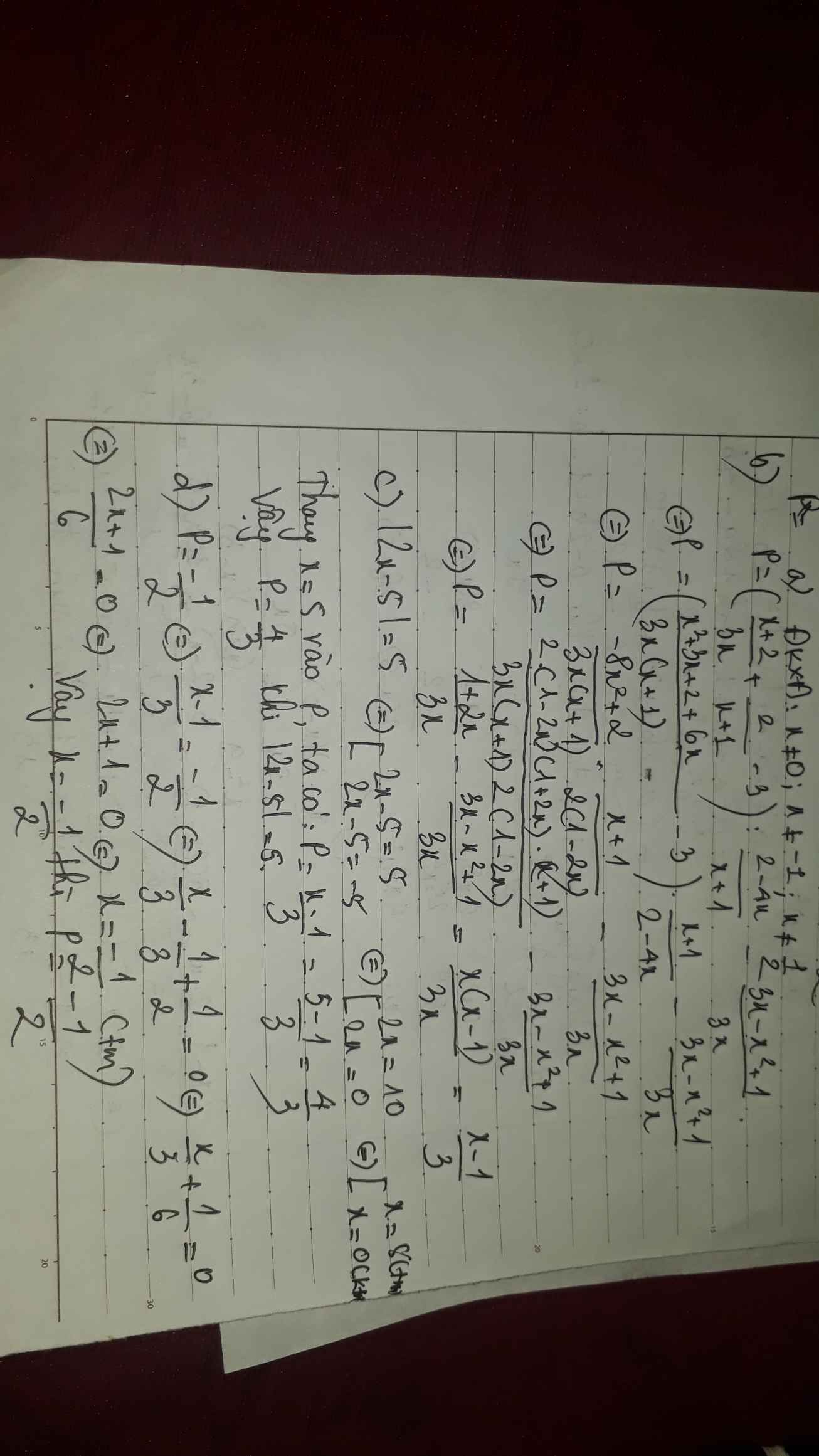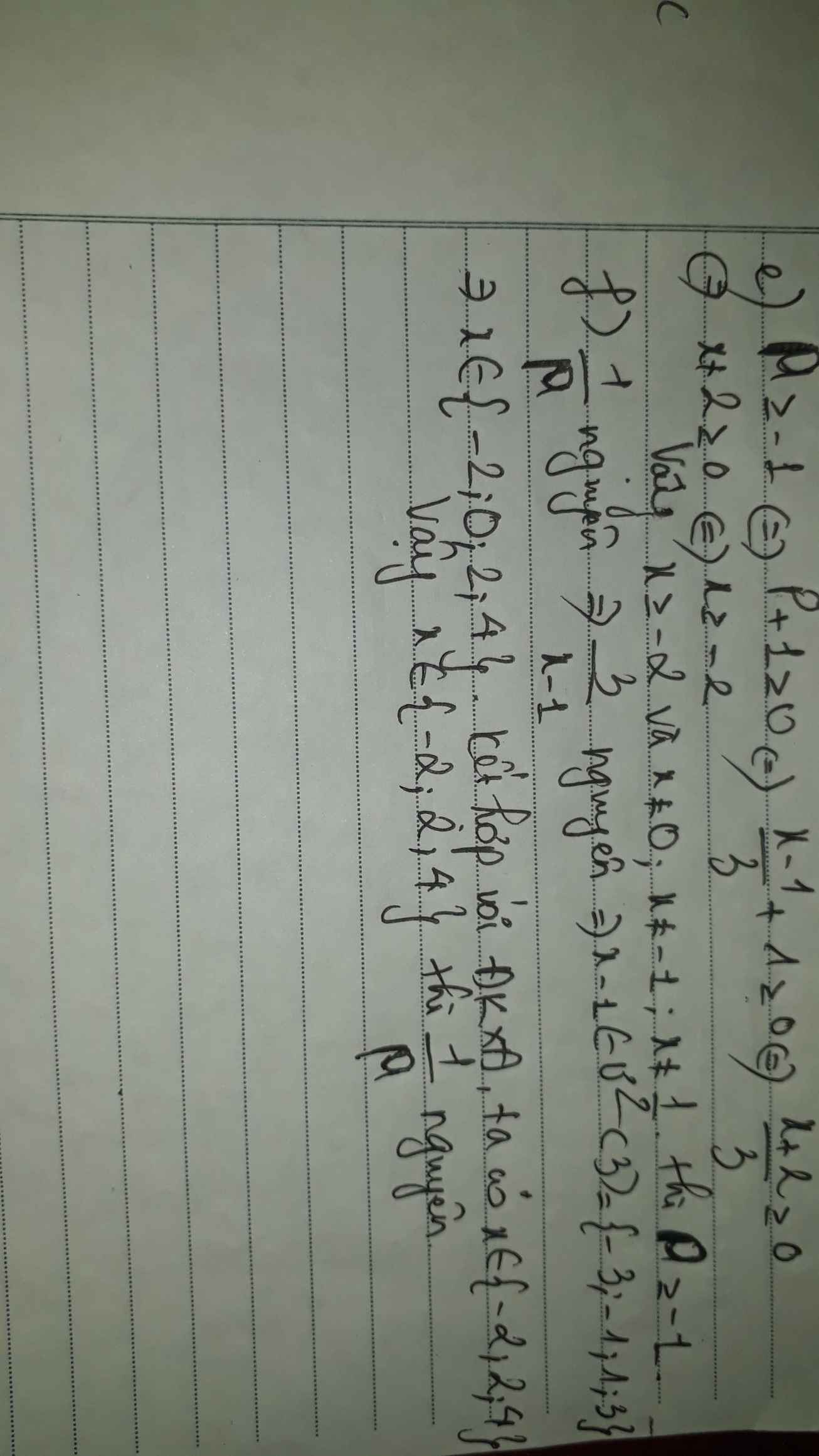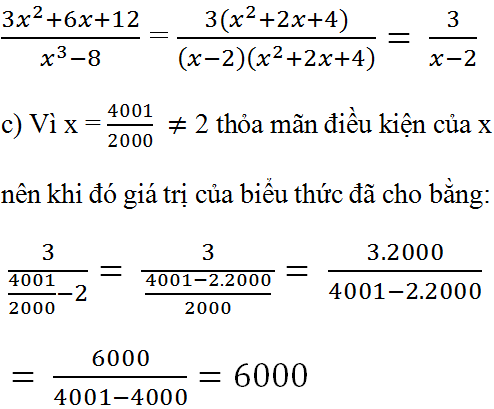Hãy nhập câu hỏi của bạn vào đây, nếu là tài khoản VIP, bạn sẽ được ưu tiên trả lời.

Bài 1: ĐKXĐ:`x + 3 ne 0` và `x^2+ x-6 ne 0 ; 2-x ne 0`
`<=> x ne -3 ; (x-2)(x+3) ne 0 ; x ne2`
`<=>x ne -3 ; x ne 2`
b) Với `x ne - 3 ; x ne 2` ta có:
`P= (x+2)/(x+3) - 5/(x^2 +x -6) + 1/(2-x)`
`P = (x+2)/(x+3) - 5/[(x-2)(x+3)] + 1/(2-x)`
`= [(x+2)(x-2)]/[(x-2)(x+3)] - 5/[(x-2)(x+3)] - (x+3)/[(x-2)(x+3)]`
`= (x^2 -4)/[(x-2)(x+3)] - 5/[(x-2)(x+3)] - (x+3)/[(x-2)(x+3)]`
`=(x^2 - 4 - 5 - x-3)/[(x-2)(x+3)]`
`= (x^2 - x-12)/[(x-2)(x+3)]`
`= [(x-4)(x+3)]/[(x-2)(x+3)]`
`= (x-4)/(x-2)`
Vậy `P= (x-4)/(x-2)` với `x ne -3 ; x ne 2`
c) Để `P = -3/4`
`=> (x-4)/(x-2) = -3/4`
`=> 4(x-4) = -3(x-2)`
`<=>4x -16 = -3x + 6`
`<=> 4x + 3x = 6 + 16`
`<=> 7x = 22`
`<=> x= 22/7` (thỏa mãn ĐKXĐ)
Vậy `x = 22/7` thì `P = -3/4`
d) Ta có: `P= (x-4)/(x-2)`
`P= (x-2-2)/(x-2)`
`P= 1 - 2/(x-2)`
Để P nguyên thì `2/(x-2)` nguyên
`=> 2 vdots x-2`
`=> x -2 in Ư(2) ={ 1 ;2 ;-1;-2}`
+) Với `x -2 =1 => x= 3` (thỏa mãn ĐKXĐ)
+) Với `x -2 =2 => x= 4` (thỏa mãn ĐKXĐ)
+) Với `x -2 = -1=> x= 1` (thỏa mãn ĐKXĐ)
+) Với `x -2 = -2 => x= 0`(thỏa mãn ĐKXĐ)
Vậy `x in{ 3 ;4; 1; 0}` thì `P` nguyên
e) Từ `x^2 -9 =0`
`<=> (x-3)(x+3)=0`
`<=> x= 3` hoặc `x= -3`
+) Với `x=3` (thỏa mãn ĐKXĐ) thì:
`P = (3-4)/(3-2)`
`P= -1/1`
`P=-1`
+) Với `x= -3` thì không thỏa mãn ĐKXĐ
Vậy với x= 3 thì `P= -1`

a) ĐKXĐ `x + 3 ne 0 ` và `x -3 ne 0` và ` 9 -x^2 ne 0`
`<=> x ne -3 ` và `x ne 3` và `(3-x)(3+x) ne 0`
`<=> x ne -3` và `x ne 3`
b) Với `x ne +-3` ta có:
`P= 3/(x+3) + 1/(x-3)- 18/(9-x^2)`
`P= [3(x-3)]/[(x-3)(x+3)] + (x+3)/[(x-3)(x+3)] + 18/[(x-3)(x+3)]`
`P= (3x-9)/[(x-3)(x+3)] + (x+3)/[(x-3)(x+3)] + 18/[(x-3)(x+3)]`
`P= (3x-9+x+3+18)/[(x-3)(x+3)]`
`P= (4x +12)/[(x-3)(x+3)]`
`P= (4(x+3))/[(x-3)(x+3)]`
`P= 4/(x-3)`
Vậy `P= 4/(x-3)` khi `x ne +-3`
c) Để `P=4`
`=> 4/(x-3) =4`
`=> 4(x-3) = 4`
`<=> 4x - 12=4`
`<=> 4x = 16
`<=> x= 4` (thỏa mãn ĐKXĐ)
Vậy `x=4` thì `P =4`
a) P xác định <=> \(\left\{{}\begin{matrix}x+3\ne0\\x-3\ne0\end{matrix}\right.\)
<=>\(\left\{{}\begin{matrix}x\ne-3\\x\ne3\end{matrix}\right.\)
<=>\(x\ne\pm3\)
b)Với \(x\ne\pm3\)
\(P=\dfrac{3}{x+3}+\dfrac{1}{x-3}-\dfrac{18}{9-x^2}\)
\(=\dfrac{3}{x+3}+\dfrac{1}{x-3}+\dfrac{18}{\left(x+3\right)\left(x-3\right)}\)
\(=\dfrac{3\left(x-3\right)+\left(x+3\right)+18}{\left(x+3\right)\left(x-3\right)}\)
\(=\dfrac{3x-9+x+3+18}{\left(x+3\right)\left(x-3\right)}\)
\(=\dfrac{4x+12}{\left(x+3\right)\left(x-3\right)}\)
\(=\dfrac{4\left(x+3\right)}{\left(x+3\right)\left(x-3\right)}=\dfrac{4}{x-3}\)
c)Với \(x\ne\pm3\)
P=4 <=>\(\dfrac{4}{x-3}=4\)
<=>\(4x-12=4\)
<=>\(4x=16\)
<=>x=4(tm)
Vậy x=4

a: ĐKXĐ: \(x\notin\left\{0;1;2;3;4;5\right\}\)
b: \(P=\dfrac{1}{x^2-x}+\dfrac{1}{x^2-3x+2}+\dfrac{1}{x^2-5x+6}+\dfrac{1}{x^2-7x+12}+\dfrac{1}{x^2-9x+20}\)
\(=\dfrac{1}{x\left(x-1\right)}+\dfrac{1}{\left(x-1\right)\left(x-2\right)}+\dfrac{1}{\left(x-2\right)\left(x-3\right)}+\dfrac{1}{\left(x-3\right)\left(x-4\right)}+\dfrac{1}{\left(x-4\right)\left(x-5\right)}\)
\(=\dfrac{-1}{x}+\dfrac{1}{x-1}-\dfrac{1}{x-1}+\dfrac{1}{x-2}-\dfrac{1}{x-2}+\dfrac{1}{x-3}-\dfrac{1}{x-3}+\dfrac{1}{x-4}-\dfrac{1}{x-4}+\dfrac{1}{x-5}\)
\(=\dfrac{1}{x-5}-\dfrac{1}{x}\)
\(=\dfrac{x-\left(x-5\right)}{x\left(x-5\right)}=\dfrac{5}{x\left(x-5\right)}\)
c: \(x^3-x^2+2=0\)
=>\(x^3+x^2-2x^2+2=0\)
=>\(x^2\cdot\left(x+1\right)-2\left(x-1\right)\left(x+1\right)=0\)
=>\(\left(x+1\right)\left(x^2-2x+2\right)=0\)
=>x+1=0
=>x=-1
Khi x=-1 thì \(P=\dfrac{5}{\left(-1\right)\left(-1-5\right)}=\dfrac{5}{\left(-1\right)\cdot\left(-6\right)}=\dfrac{5}{6}\)

a) ĐKXĐ: \(x\ne-10;x\ne0;x\ne-5\)
b) \(P=\dfrac{x^2+2x}{2x+20}+\dfrac{x-5}{x}+\dfrac{50-5x}{2x\left(x+5\right)}\)
\(=\dfrac{x^2+2x}{2\left(x+10\right)}+\dfrac{x-5}{x}+\dfrac{50-5x}{2x\left(x+5\right)}\)
\(=\dfrac{x\left(x^2+2x\right)\left(x+5\right)}{2x\left(x+10\right)\left(x+5\right)}+\dfrac{2\left(x-5\right)\left(x+10\right)}{2x\left(x+10\right)\left(x+5\right)}+\dfrac{\left(50-5x\right)\left(x+10\right)}{2x\left(x+5\right)\left(x+10\right)}\)
\(=\dfrac{x^4+7x^3+10x^2+2x^2+10x-100+500-5x^2}{2x\left(x+10\right)\left(x+5\right)}\)
\(=\dfrac{x^4+7x^3+7x^2+10x+400}{2x\left(x+10\right)\left(x+5\right)}\)
c) \(P=0\Rightarrow x^4+7x^3+7x^2+10x+400=0\Leftrightarrow...\)
Số xấu thì câu c, d làm cũng như không. Bạn xem lại đề.

\(a,P=\left[\dfrac{x+1}{3x\left(x+1\right)}-\dfrac{2x-1}{3x\left(2x-1\right)}-1\right]\cdot\dfrac{2x}{1-x}\left(x\ne1;x\ne-1;x\ne0\right)\\ P=\left(\dfrac{1}{3x}-\dfrac{1}{3x}-1\right)\cdot\dfrac{2x}{1-x}\\ P=-1\cdot\dfrac{2x}{1-x}=\dfrac{2x}{x-1}\\ b,P=2+\dfrac{2}{x-1}\in Z\\ \Leftrightarrow x-1\inƯ\left(2\right)=\left\{-2;-1;1;2\right\}\\ \Leftrightarrow x\in\left\{2;3\right\}\left(x\ne-1;x\ne0\right)\\ c,P\le1\Leftrightarrow\dfrac{2x}{x-1}-1\le0\\ \Leftrightarrow\dfrac{x+1}{x-1}\le0\\ \Leftrightarrow\left[{}\begin{matrix}\left\{{}\begin{matrix}x+1\le0\\x-1>0\end{matrix}\right.\\\left\{{}\begin{matrix}x+1\ge0\\x-1< 0\end{matrix}\right.\end{matrix}\right.\Leftrightarrow-1\le x< 1\)
a: \(P=\left(\dfrac{x+1}{3x\left(x+1\right)}-\dfrac{2x-1}{3x\left(2x-1\right)}-1\right)\cdot\dfrac{2x}{x-1}\)
\(=\dfrac{1-1-3x}{3x}\cdot\dfrac{2x}{x-1}\)
\(=\dfrac{-3x}{3x}\cdot\dfrac{2x}{x-1}=\dfrac{-2x}{x-1}\)



a, P xác định khi \(x^3-8\ne0\)
\(\Leftrightarrow\left(x-2\right)\left(x^2+2x+4\right)\ne0\)
\(\Leftrightarrow x\ne2\left(\text{Vì }x^2+2x+4>0\right)\)
b, \(P=\dfrac{3x^2+6x+12}{x^3-8}=\dfrac{3\left(x^2+2x+4\right)}{\left(x-2\right)\left(x^2+2x+4\right)}=\dfrac{3}{x-2}\)
c, \(x=\dfrac{4001}{2000}\Rightarrow P=\dfrac{3}{\dfrac{4001}{2000}-2}=6000\)